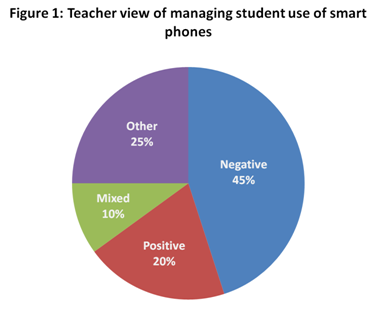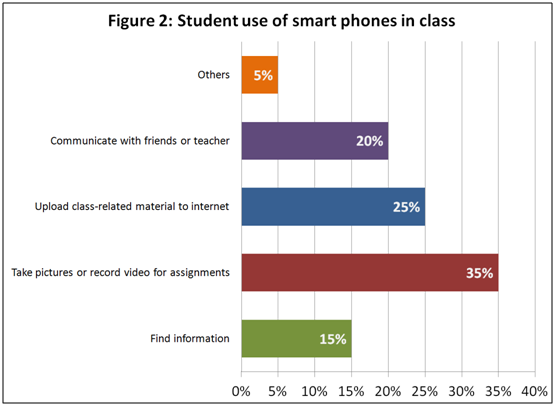WRITING Task 1 - Practice Questions
Smart Phones in Class
The charts below give information about teachers’ views of managing student use of smart phones in the classroom, and secondly, how students use smart phones in the class.
Summarise the information by selecting and reporting the main features, and make comparisons where relevant.
You should write around 150 words. You are advised to spend no more than 20 minutes on this task.


Possible Answer for Smart Phones in Class with Comments 1
The above pie chart illustrates opinion of teachers towards controlling student use of smart phones in classroom whereas the below bar chart shows their main purposes of using smart phones in class.
From the pie chart, it is shown that nearly a half hold negative view on this issue. On the other hand, one fifth of teachers have positive response regard this. In this case, a quarter of teachers hold other views while only a small minority, 10% left for mixed opinion.
Before further analysis, a glance on how students use smart phones in class is necessary. From the bar chart, taking pictures or record video for assignments accounts for more than a third proportion. The percentages for upload class-related material to internet and communicate with friends or teacher are quite similar, at 25% and 20% respectively. Less than a fifth students use phones to find information. The remaining 5% is accounted for other usage.
The significant number of teachers hold negative view towards the usage of smart phones in class may be due to the preserving privacy as most students use phones to take picture or record video in class. This may cause uncomfortableness of teachers.
(197 words)
Comments:
This answer mostly addresses the requirements of the task and is logically laid out in four paragraphs. The writer has successfully changed the vocabulary and grammar to introduce the two charts. S/he has also used a mix of figures and language of approximation to give details.
The writing would benefit from better linking between the ideas in each paragraph. For example, writing ‘in contrast’ instead of ‘on the other hand’ in paragraph two, would highlight the difference between the larger number of teachers expressing negative views and the smaller number expressing positive ones. The linker ‘in this case’ is not appropriate here because it does not refer to a previously defined situation. ‘At the same time’ would be better.
Paragraph two also has some unclear information, for example, ‘nearly a half hold negative view on this issue’. Nearly a half of who or what? Which issue?
The writer’s conclusion is an assumption rather than a direct reference to information in the charts. A conclusion for task 1 should be about the general trend(s), e.g. although many students use smart phones for class-related purposes, few teachers have wholly positive attitudes toward the management of this technology.
Possible Answer for Smart Phones in Class with Comments 2
Students using smartphones in class has become a typical phenomenon in recent years. When it comes to managing this behaviour, teachers hold diverse views.
Figure 1 shows that almost half (45%) of the teachers interviewed found it difficult to manage student use of smartphone in the classroom and might have negative thoughts towards that. This somehow corresponds to the reasons why students look at their screens during their learning time. These reasons are shown in Figure 2 -- 20% of the interviewees admitted that they used the devices for non-academic use, mainly to communicate with friends.
However, the teachers’ stand may not be completely justified. Among all the student respondents, the largest proportion (35%) of them claimed they take pictures or record videos with their phones for assignment-related purposes. A small proportion of them (15%) said finding information, possibly for study reasons, is the most common intention.
These two figures have illustrated how teachers and students see the use of smartphones at school differently. Perhaps the two parties could communicate with each other, hoping to take advantage of current technology.
(180 words)
Comments:
This writing uses a wide variety of grammar structures to communicate the message. There is good use of referring phrases to connect ideas together, for example, ‘towards that’, ‘This somehow’, ‘These reasons’ and ‘the largest proportion of them’.
The writing would benefit from more focus on the task requirements. An introduction stating what the charts represent would set the context more effectively. Not enough information is given about the teacher view of managing student use of smart phones. More figures are given for how the students use their phones but the writer’s feelings dominate the description (e.g. ‘the teacher’s stand may not be completely justified’).
A better summary of the general trend is needed; ‘teachers hold diverse views’ is too vague. The writer could have contrasted the fact that although many students use smart phones for class-related purposes, few teachers have wholly positive attitudes toward managing this technology in the classroom.
Possible Answer for Smart Phones in Class with Comments 3
The given information indicates the condition of students’ use of smartphones and teachers’ perspectives on managing their usage of such gadgets in the classroom.
Nearly half of the teachers hold negative opinions towards the handling of their students employing smart phones during the lessons while only twenty percent of the teachers show positive attitude about the management of it. At the same time, twenty five percent of the teachers have other perspectives and ten percent of them have mixed feelings about it.
The reasons of the majority of teachers showing unfavorable perception towards their management on students’ use of smart phones can be attributed to the difficulty of exerting control over students’ learning and maintaining good learning atmosphere in the class. The most common functions of using smartphones in class such as students taking pictures or recording video for assignments, uploading materials to internet and communicating with others, which may hinder themselves or other students from following teachers’ teaching.
In conclusion, although some students try to make good use of their phones to enhance learning such as searching for information for the lesson, there are still more students become less attentive to teachers’ teaching because phones are often used.
(199 words)
Comments:
The writing addresses the task and is logically organised into four paragraphs. The writer has used a good variety of structures and vocabulary to explain the data. S/he has also used linking words and phrases well: ‘Nearly half…while only’, ‘At the same time…mixed feelings about it’, ‘such as…which may hinder’, ‘In conclusion, although…’
The writer has used figures appropriately to give detail about teacher’s views but note that writing out figures in word form could cost time in the test. Mathematical figures (20%, 25%, etc.) are fine but it is also a good idea to use some language of approximation (e.g. ‘Nearly half’ instead of 45%) as this writer has done.
This answer needs some figures to describe student use of smart phones in class. It also needs to focus more on what can actually be seen in the charts. The data given does not show that ‘students become less attentive to teachers’ teaching because phones are often used’. Refer to the high-level answer for a more objective conclusion.
Possible Answer for Smart Phones in Class - High-Level Answer
The two figures presented relate to the use of smart phones in the classroom. The pie chart reflects teacher attitudes toward managing student smart phone use and the bar chart shows how students use these devices in class.
As can be seen from the pie chart, almost half of the teachers hold negative views toward handling student smart phone use in class. In contrast, only one fifth of them are positive about the management of smart phone use. The remaining educators express either mixed views (10%) or other views (25%).
Students predominantly use their smart phones for taking pictures or recording videos for assignments (35%), and uploading class-related material to the internet (25%). In addition, a fifth of the learners communicate with friends or the teacher with their smart phones and about one-sixth of them use their phones to search for information. A minority of pupils (5%) use their smart phones for other purposes.
The data appears to present a paradox in that although a majority of students use their smart phones for class-related purposes, few teachers are satisfied that they can manage classroom use of this technology.
(188 words)